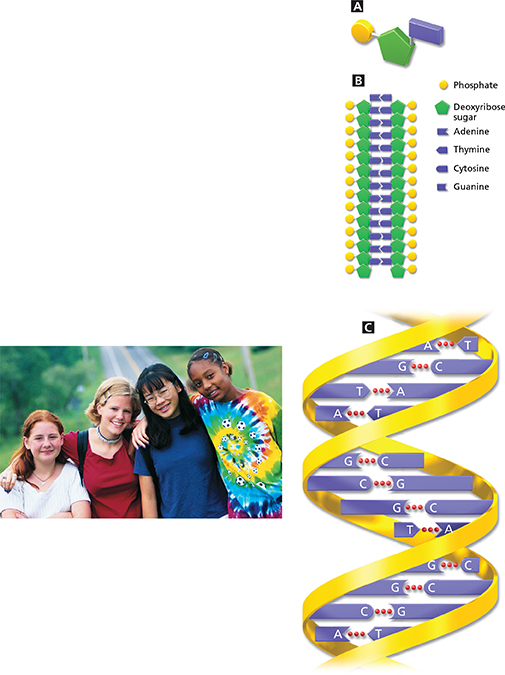Nucleic Acids
There are molecules in each cell of a plant or animal that store information about its structures and functions. These molecules are nucleic acids. Nucleic acids are large, nitrogen-filled polymers found mainly in the nuclei of cells. There are two types of nucleic acid, deoxyribonucleic acid (DNA) and ribonucleic acid (RNA).
The monomers in a nucleic acid are nucleotides. Figure 16A shows the three parts of a DNA nucleotide. The yellow circle represents a phosphate group. The green pentagon represents deoxyribose sugar, which has a five-atom ring. The purple rectangle represents an organic base. The bases in DNA are adenine, thymine, cytosine, and guanine.
When two strands of DNA line up as shown in Figure 16B, an adenine base always pairs up with a thymine base, and a cytosine base always pairs up with a guanine base. These pairs of bases are arranged like the rungs of a ladder. The strands are held together by strong intermolecular attractions between hydrogen atoms on one strand and nitrogen or oxygen atoms on the other strand. Figure 16C shows how the strands twist around each other in a structure called a double helix. The order of the base pairs in a strand is a code that stores information that is used to produce proteins.

What are the two types of nucleic acids?
Figure 16 Nucleic acids are polymers that store the genetic information that gives the girls in the photograph their distinct physical characteristics. GC A The monomers in DNA have three components—a phosphate group, a sugar, and one of four organic GC bases. B Two strands of DNA are held together by intermolecular attractions between the organic bases. C The shape of DNA is like a twisted ladder. Phosphatesugar chains form the sides of the ladder. The rungs of the ladder are pairs of bases.
 d
d



